“Friendly Competition”: A Network of Collecting Postwar Italian Art in the American Midwest
Sharon Hecker Sharon Hecker Methodologies of Exchange: MoMA’s “Twentieth-Century Italian Art” (1949), Issue 3, January 2020https://italianmodernart-new.kudos.nyc/journal/issues/methodologies-of-exchange-momas-twentieth-century-italian-art-1949/
Collecting art is usually seen as an individual occupation, motivated by personal passion, desire to possess, and economic investment. This paper suggests that there are social aspects of collecting that need to be considered as well. These aspects can lead to a form of “friendly competition” among local collectors. This is evident in the case of St. Louis and the collecting of postwar Italian art. Through interviews with family members and research into archival materials, this paper traces the identities of collectors (Pulitzer, Weil, Shoenberg, May, and Bernoudy) and examines the mechanisms through which productive rivalries arose. It concentrates on the collections of the Kemper Art Museum and the Saint Louis Art Museum, where one finds similar-looking works by Alberto Burri, Afro, and Marino Marini, made in the same years and bought by local collectors in the same period.
What were the relationships and connections that developed between St. Louis collectors of postwar art? How did this web develop into a community or social group, and how did this lead to donations of works to local museums? What were the relationships between these collectors and the 1949 MoMA exhibition Twentieth-Century Italian Art and its organizers? How did MoMA shows, prepackaged for further exhibition in the Midwest, influence collectors’ tastes? How did travel abroad to exhibitions such as the Venice Biennale affect acquisition habits? Whose opinion did the collectors trust and which dealers did they buy from? Such questions and their ramifications are discussed before the paper concludes with a consideration of the process through which St. Louis collectors were identified in Harold Rosenberg’s 1965 Esquire article on tastemakers in the field of contemporary art.
Collecting art is commonly seen as an individual pursuit, a quest motivated by personal passion, desire to possess, or economic investment. A phenomenon that has received less attention is the fact that collecting may involve networks of collectors who are interested in a common theme, artist, or period of art. Such networks can spread outward to reach a wide range of cities, countries, exhibitions, dealers, and curators. As well, they can be influenced by local, national, and international events. This essay highlights networks of collectors, examining their interactions and the effect they had on shaping public taste. My analysis aims to contribute to the study of networks in the art world as a growing field that has until now focused on the role of artists’ networks but not on those who collected, promoted, and exhibited artworks.1
The acquisition patterns of postwar Italian art in St. Louis, Missouri, can serve as a model for examining networks of collecting and the entry of postwar Italian art into public collections in the U.S. As a case study, I will look at such works found in the permanent collections of the Washington University Gallery of Art (known today as the Mildred Lane Kemper Museum of Art at Washington University) and the City Art Museum of St. Louis (known today as the Saint Louis Museum of Art). The two museums include similar-looking contemporaneous works by Alberto Burri, Afro Basaldella, and Marino Marini that were bought by St. Louis collectors in the same midcentury period and then donated.
Within the networks of collecting formed in St. Louis, a “friendly competition”2 emerged among collectors vying for works by similar artists. Through a series of interviews with collectors and family members as well as research into archival materials, I trace the histories of collectors that belong to the same network and consider the mechanisms that developed among them, leading to acquisitions and donations.3 The common impetus for all collecting of postwar Italian art was provided by the landmark exhibition, Twentieth-Century Italian Art, held at the Museum of Modern Art in New York in 1949. With the MoMA show as external motor, the museums in St. Louis were able to build two collections that went beyond the initial stimulus, extending and diversifying the artists and artworks collected.
The history of collectors of Italian art in St. Louis should first be contextualized within the broader history of American art collecting and existing models for researching patterns of art purchasing. It is useful to consider the situation in St. Louis with reference to studies on major nineteenth- and twentieth-century American collectors such as Albert Barnes, Louisine and Henry Osborne Havemeyer, Charles Lang Freer, and John Pierpont Morgan. Thus far historians have maintained a methodological approach that focuses on these collectors as individuals.4 Writing in the late 1950s on “the lives, times, and tastes of some adventurous American art collectors,” Aline Bernstein Saarinen described them as “the proud possessors.”5 In this respect, St. Louis collectors were no different – they followed in the same tradition. Marked by American individualism, such collectors were mostly entrepreneurs/businessmen or wealthy couples who sought to distinguish themselves and acquire a lasting name as well new knowledge and aesthetic appreciation. In collecting art, they became cultural trailblazers.
In contrast to the transformation of European private collections into public museums, U.S. museums typically began as public institutions. Since the late nineteenth century, U.S. collectors were concerned about the lack of art in the country’s cultural institutions with respect to Europe. They therefore collected with the intention of ultimately sharing their works with a public audience. While they belonged to the economic elite, they shared egalitarian ideals of “art for everyone” and the pursuit of joy through aesthetics. For U.S. collectors from the late nineteenth century and throughout the postwar period, buying art in Europe was relatively simple, with few obstacles. Indeed, this form of culture became both fashionable and an attractive economic investment.6
In his study on collecting in early modern Europe, philosopher and cultural historian Krzysztof Pomian proposed a different methodological approach to histories of collecting: he shifted from a focus on individual collectors to a sociological analysis of the collections themselves to thereby develop a theory of collecting.7 Moving from biography to cultural history, he went beyond the question of why certain people collected and towards an examination of what was collected.
A third approach, hitherto unexplored, would be to examine the impact of networks and social interactions among collectors around their acquisitions. Some of the questions I have been examining in my research are: What were the relationships and connections that developed among St. Louis collectors of postwar art? How did this local social web become a loose community of collectors, and how did this lead to the next step of donating works to local museums? What was the impact of relationships between such networks and curators or museum directors with respect to acquisitions and exhibitions that were mounted in these years? What were the relationships between collecting Italian art in St. Louis in the 1950s and 1960s and MoMA’s Twentieth-Century Italian Art exhibition in 1949, which defined many subsequent exhibitions throughout the U.S.?8 How did MoMA’s shows, often prepackaged for later exhibition in the Midwest, influence St. Louis collectors’ tastes? How did travel abroad to exhibitions such as the Venice Biennale affect their acquisition habits? Which dealers did they buy from and whose opinions did they trust? How did it come about that St. Louis collectors were identified in a 1965 Esquire article by Harold Rosenberg as tastemakers in contemporary art?9
It is clear that Saint Louis collecting was strongly based in a broad notion of the need to develop U.S. cultural patrimony through public institutions such as museums, which in turn needed to be filled with art. My investigation here was not planned to be exhaustive, but rather to shed light on one aspect of the collecting patterns in a network.10 At this stage, it seems premature to draw conclusions about the construction of hegemonic groups and hegemonic taste within American society, although this is certainly a subject worthy of research.
Turning to the specifics of St. Louis and the collectors of Italian art there, various groups of related works in the collections of the museums known today as the Kemper and the Saint Louis Art Museum are striking. The first group includes three drawings by Marino Marini donated to what was then known as the City Art Museum of St. Louis: two from 1950 that were donated by Joseph Pulitzer, Jr. (Acrobata e due cavalli [Acrobat and Two Horses] and Due acrobati e un cavallo [Two Acrobats and a Horse]) in 1955 and 1967 respectively, and another from 1951 gifted to the museum by Mr. and Mrs. Morton D. May (Cavaliere e cavallo [Horse and Rider]) in 1956. A fourth related drawing, from 1957 (Cavallo e due acrobati [Horse and Two Acrobats]; figure 1), was purchased a few years later by Mr. and Mrs. John Shoenberg from the Pierre Matisse Gallery in New York and donated to what was then known as the Washington University Gallery of Art in 1961.
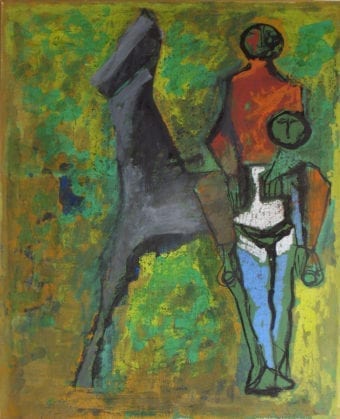
Similar works by Afro include Una crisi di coscienza (A Crisis of Conscience, 1951; figure 2), exhibited in the gallery of Catherine Viviano in Manhattan in 1952 and sold in 1954 to Pulitzer, who donated it to the City Art Museum of St. Louis in 1967.11 Not to be outdone, in May 1955, Richard and Florence Weil also purchased a work by Afro from Viviano, Il giardino della speranza (The Garden of Hope, 1954; figure 3), which they donated to the Washington University Gallery of Art in 1962. Although the subjects differed, the two works are stylistically similar and almost identical in size.
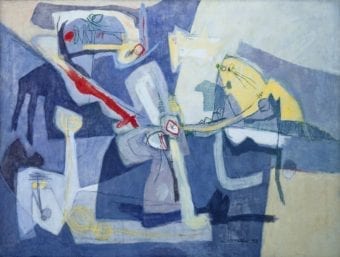
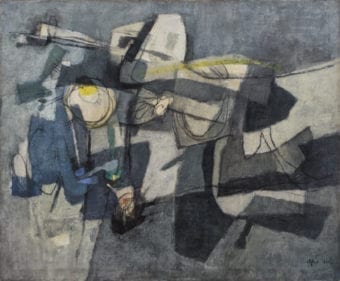
“Il Giardino della Speranza” [The garden of hope], 1954. Oil on canvas, 57 x 68 7/8 in. (144. 7 x 174.9 cm). Mildred Lane Kemper Art Museum, Washington University in St. Louis. Gift of Mr. and Mrs. Richard K. Weil, 1962. © 2019 Artists Rights Society (ARS), New York / SIAE, Rome.
In March 1960, Pulitzer acquired Burri’s Grande Ferro M1 (Large Iron M1, 1958; figure 4) from Martha Jackson Gallery in New York. Following on his heels, in 1961 Weil purchased Grande Ferro M3 (Large Iron M3, 1959; figure 5) directly from Burri via Odyssia Skouras at the Galleria Odyssia in Rome. Both collectors donated their Burris – of the same materials, roughly the same size, and very similar title and subject – to the Washington University Gallery of Art soon after.12
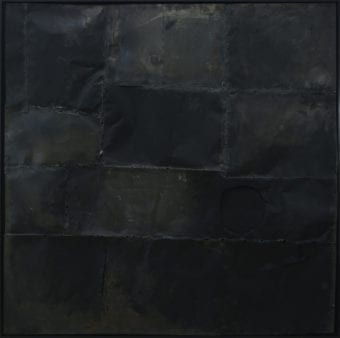
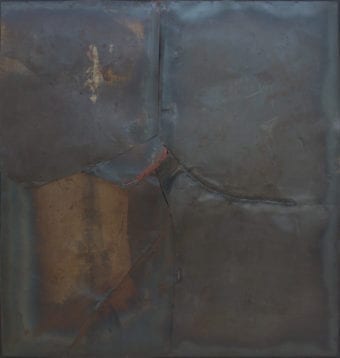
The closeness of acquisition dates and similarities in subject, medium, and size are surely not coincidental. They make sense if one sees this form of collecting in terms of “friendly competition.” The Pulitzers and the Weils were the two main collector-couples in St. Louis, although others, such as Mr. and Mrs. John Shoenberg (the Shoenberg family had established a dry goods businesses that became part the May Department Stores Company), Mr. and Mrs. Morton D. “Buster” May (founder of May Department Stores Company), and architect William Bernoudy (student of Frank Lloyd Wright) also collected Italian postwar art in the 1950s; together their donations created a sizeable collection between the two museums, of works by Afro, Renato Birolli, Bruno Caruso, Burri, Giuseppe Capogrossi, Pietro Consagra, Pericle Fazzini, Lucio Fontana, Giacomo Manzù, Marini, Luciano Minguzzi, Luigi Parzini, Oscar Piattella, Toti Scialoja, Tancredi, and Massimo Campigli, among others. The collectors’ mutual interest in Italian art was part of American collectors’ broader interest in postwar European art; the larger focus in St. Louis specifically seems to have been on Italian, French, Spanish, and some British art, as well as art from the CO.BR.A movement (the name stands for Copenhagen, Brussels, and Amsterdam, the cities from which the artists who formed the group came from).13 It should be noted that some of these artists were exhibited in 1949 at MoMA’s Twentieth-Century Italian Art exhibition (Afro, Fazzini, Fontana, Manzù, Scialoja, and Campigli), while others were not (Birolli, Caruso, Burri, Capogrossi, Consagra, Minguzzi, Parzini, Piatella, and Tancredi). Many of the latter artists were introduced on the U.S. market by dealers such as Catherine Viviano and Rome’s Galleria dell’Obelisco after the 1949 show.
Some details about the individuals involved are necessary before discussing this collecting network. Joseph Pulitzer, Jr., was the pioneer and most prolific collector, with Weil following suit. As a well-known newspaper publisher, Pulitzer began buying postwar Italian art in the early 1950s. For nearly two decades, between 1951 and 1968, he acquired sculptures, paintings, and works on paper by Marini, Afro, Burri, Capogrossi, Caruso, Birolli, Fontana, and Andrea Cascella. The reasons for Pulitzer’s interest in contemporary Italian art are not made explicit in his biography and are hard to trace.14
By collecting modern European art and maintaining constant contact with national and international cultural events, Pulitzer was well positioned to appreciate the latest artistic developments in postwar art from various countries. When he began to buy Italian art, his reputation as a collector of modern European art, especially the École de Paris, was already established. Though based in St. Louis, Pulitzer, like his fellow collectors, traveled regularly to exhibitions in Chicago, Washington, D.C., Boston, and New York, as well as throughout Europe; indeed, his national and international contacts in the art world were extensive.15
The early date of Pulitzer’s attention to contemporary Italian art is noteworthy. He began buying these works when U.S. market interest was in its initial stages. The purchase of Italian art would have appeared particularly advantageous to American buyers given Italy’s shattered postwar economy. Price lists reveal that these artworks were initially minimal investments, though this situation changed significantly after the mid-1950s, when prices of works by many Italian artists tripled.
Another reason for Pulitzer’s turn to acquiring Italian art could have been its social and political overtones, which possibly resonated with his spirit. The move to buy Italian contemporary painting and sculpture was part of a broader resistance on the part of collectors (many of whom were Jewish) to supporting German-made products after the war. U.S. financial support for Italy – especially given the Marshall Plan’s heavy investment in rebuilding the country – was a leitmotif throughout the late 1940s. Buying Italian art could be seen as a way to contribute to this greater cause.16
Certainly, MoMA’s midcentury Twentieth-Century Italian Art exhibition, organized by Pulitzer’s friend and MoMA director Alfred H. Barr, Jr., with James Thrall Soby, was influential on his collecting. Pulitzer’s acquisitions generally came from the most important New York dealers in the promotion of contemporary Italian art, such as Viviano, Curt Valentin, and Martha Jackson. Pulitzer’s first purchase of a Marini drawing came only two years after a Marini sculpture was shown at MoMA in 1949 – before Marini’s reputation began to spread across the U.S.17 At midcentury, Marini’s work was being collected only in the most sophisticated circles – acquisitions were made by Mary and Henry Gates Lloyd; Nelson Rockefeller; Blanchette and John D. Rockefeller; department store owner and philanthropist Edgar J. Kaufmann; and Soby, the MoMA show’s co-curator, who commissioned from Marini a portrait of his wife, Nelly. Pulitzer’s choice of gestural drawings rather than sculpture by Marini is noteworthy, for the drawings are more forward-looking, bold, and exciting than his sculptures, which suggest the archaic.
Similarly, Pulitzer’s acquisition from Viviano of paintings by Afro between 1952 and 1957 confirms his anticipation of Afro’s importance. Afro had exhibited in the U.S. before the war, but in the postwar period he was present in major shows such as MoMA’s Twentieth-Century Italian Art, Handicraft as Fine Art in Italy (held at the House of Italian Handicraft in New York in 1947), and The New Decade: 22 European Painters and Sculptors, again at MoMA (1955). In 1954, Pulitzer bought Portico d’Ottavia (Portico of Ottavia, 1943) directly from the artist. In 1955, he acquired an Afro made that year, Per una ricorrenza (For an Anniversary, 1955), from another solo show at Viviano’s gallery, which he later donated to the Solomon R. Guggenheim Museum. This is interesting, considering that the New York museum’s directors wanted little to do with Peggy Guggenheim, who had been collecting Italian contemporary art in Venice for a long time by then. Finally in 1957, Pulitzer purchased Terra di Quercia (Land of Oaks, 1956; figure 6), again from Viviano, and gifted it to the Washington University Gallery of Art in 1966. He donated El Sereno (Night Watchman, 1955) to the Museum of Fine Arts in Boston in 1959. Other acquisitions by Pulitzer include a gouache by Capogrossi (Tema etrusco [Etruscan Theme], 1953) bought in 1954 from the Schneider Gallery in Rome, and an ink drawing by Caruso (Lo zoo [The Zoo], 1954), bought in 1955 from Arthur Jeffress’s gallery in London; both were donated to the City Art Museum of St. Louis, in 1958 and 1959 respectively.
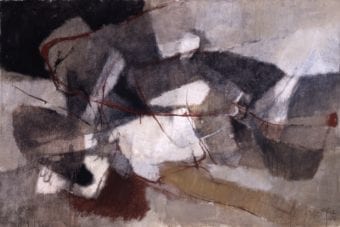
Pulitzer continued to acquire Italian works after 1955, such as a painting bought in 1958 directly from Birolli (Memoria del Veneto [Memory of the Veneto], 1957; figure 7) and gifted to the Washington University Gallery of Art in 1962, and Caruso’s The Factory (1958) which he purchased from Jeffress in London in 1958 via the Galleria dell’Obelisco in Rome, after the work had already been exhibited in Rome and London. Pulitzer gifted it to the City Museum of Art in St. Louis in 1959. As mentioned earlier, Pulitzer acquired and donated the Burri Grande Ferro M1 (1958) in 1960; by that year, Burri was well known and widely collected in the U.S. (In 1954, Martha Jackson had been attracted to Burri’s work when it was exhibited in Rome at the Obelisco, in the exhibition Major Works, Minor Scale, which circulated to eleven venues in the U.S. and Canada between 1955 and 1957.) Pulitzer also bought works by Fontana, including Concetto spaziale nero (Spatial Concept Black, 1966) and Concetto Spaziale, New York 22 (Spatial Concept, New York 22, 1962), from dealers who emerged in the 1950s, among them Beatrice Monti of the Galleria dell’Ariete in Milan.
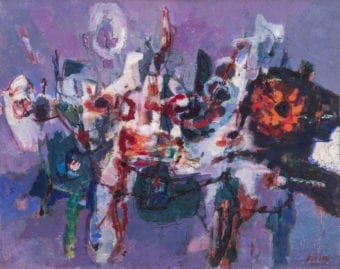
To date there has not been a published study of Richard and Florence Weil and their contribution to collecting postwar art in St. Louis. Florence was the daughter of Etta Steinberg, a St. Louis collector of modern European art.18 Etta was advised and endorsed by local, national, and European critics, dealers, and cultural figures such as such as Harold Rosenberg, Pierre Matisse, Galerie Beyeler, Fritz Nathan, Sam Salz, Paul Rosenberg, Gimpel Fils, Knoedler Gallery, and Louise Leiris. Although she did not typically acquire postwar Italian art, Etta did buy a Pietro Consagra, which she donated to the Washington University Gallery of Art. As art historian Elizabeth Childs has shown, Steinberg wished for St. Louis to have the national and international profile enjoyed by New York, Boston, and Chicago. Etta also shared a concept of “Jewish womanhood,” as Childs calls it, which believed in philanthropy.19 Etta was aided by the healthy postwar economy: the 1950s was a golden age of philanthropy due to tax breaks and incentivized giving programs initiated by President Franklin D. Roosevelt. Ample private resources were directed to develop museums, universities, and nonprofit art institutions. Steinberg’s home was a destination for out-of-town visitors such as the board members of MoMA. She benefited from the advice of Perry T. Rathbone, director of the City Art Museum of St. Louis until 1955, and William Eisendrath, who joined the staff in 1952 and wrote about her collection in Connoisseur Magazine.20 Letters show that Eisendrath advised her not to buy works that would overlap with other private collections in town; in one case he told her that the Shoenbergs already owned a cast of a sculpture she was considering. It seems that Eisendrath had an expansive vision for the mission of the St. Louis collecting network.
Etta’s daughter Florence and her son-in-law Richard K. Weil would often accompany her on her art-seeking trips to Europe. In 1959 they visited Peggy Guggenheim,21 who may have functioned as an influencer and go-between. The Weils’ son John recalls dinners with Sir Herbert Read in Venice, and that Rathbone came with them on one trip, during which the children were skirted off to see a collector of ancient Italian art in a villa while their parents were visiting Guggenheim.
John Weil confirmed to me that St. Louis’s most important collectors – the Pulitzers, Bernoudys, Weils, Mays, and Shoenbergs – were socially intertwined, although they did not all travel in the same social or economic circles. Weil defines these collectors as “a group of people who had art in common.”22 They were very friendly with each other, frequently discussed collecting, and exchanged information. Many of them were Jewish, but they were not religious and did not attend synagogue. They did, however, play tennis at the Westwood Country Club, the Jewish country club of St. Louis. Weil recalls at least one City Art Museum of St. Louis party at their home, which many of the collectors attended. The children of these collectors were friendly as well. There were moments of social conviviality at the art museums and the symphony, to which all had subscriptions. On such occasions, art was always discussed. The university setting further helped to coalesce the group. They all traveled to the Venice Biennales, although not together.
Richard Weil went to New York frequently, but bought more art in Europe. His son recalls that he would go around to dealers and art people to “figure out who were the up-and-coming artists.”23 The economic situation was advantageous for buying. Finally, what emerged from my interview with John Weil is that this group shared the same philanthropic goals, especially their willingness to give significant art to the city. “People did not start their own art museums – it was not all about them but about giving to the community.”24
The same people helped shape St. Louis collectors’ tastes. Although Rathbone was not always universally liked in St. Louis, Weil feels that he did build camaraderie among the collectors. In art historian Kate Butler’s opinion, Eisendrath was enormously influential. He benefitted from a friendship with James Johnson Sweeney, who, as curator at MoMA and later director of the Guggenheim in New York, probably influenced Eisendrath’s interest in pre- and postwar abstract art.
The apex of the St. Louis collecting network was a 1955 exhibition curated by Eisendrath and called Contemporary Italian Art: Paintings, Drawings and Sculpture, at the City Art Museum of St. Louis. Butler describes it as a major international loan exhibition drawn from collections throughout the U.S. and Italy. It was the first exhibition Eisendrath curated at the museum and it benefitted immensely from his close network of St. Louis collectors.25
Eisendrath modeled his show on Twentieth-Century Italian Art, making the relationship between the New York and the St. Louis exhibition clear. The idea for the show was given to him by Rathbone. Numerous loans came from MoMA, and the exhibition catalogue’s acknowledgements profusely thank Soby, Barr, and Andrew Carnduff Ritchie (the director of the Albright Gallery from 1949, who, in 1957 would become director of the painting and sculpture department at MoMA).26 The show included thirty-four artists, nineteen of whom had been featured in one-person shows at the Venice Biennale. Viviano loaned heavily to the 180-work show, which she may have seen as an opportunity to showcase works for sale. A bronze Marini sculpture, Horse and Rider (1949), acquired by the City Art Museum of St. Louis, was chosen for the catalogue’s cover.27
According to Butler, the exhibition reflected Italian art’s appeal to the group of local collectors who lent to it. Unlike exhibitions of European art organized by major U.S. institutions slightly later into the 1950s, Contemporary Italian Art did not favor abstraction. Rather, it presented social realism (for example, Renato Guttuso) alongside abstraction (Emilio Vedova). Eisendrath aimed to demonstrate American openness to a variety of styles and the cultural creativity of postwar Italy. In a nod to the narrative established by Barr and Soby in the MoMA show, Eisendrath linked contemporary Italian artists to precedents in European modernism (Pablo Picasso, Georges Braque, and Wassily Kandinsky). Afro’s work was given its own room. He commented in a letter to Scialoja that he was amazed to be “received like a great personality,” and found himself “at the center of academic conferences and television interviews.”28
So appreciative of Italian contemporary art was St. Louis that, in the spring of 1961, a show dedicated to sculpture, Italian Sculptors of Today, was organized by the Galleria Odyssia for the Washington University Gallery of Art.29 It subsequently circulated to the Dallas Museum for Contemporary Arts and the New Orleans Museum of Art. In one photograph from the St. Louis opening, Consagra is seen with dealer Odyssia Skouras, while in another, Pulitzer can be glimpsed through a mesh of sculpture.
The study of the St. Louis collecting network helps understand the broader critical fortune of Italian modernism in the U.S. If, for Midwestern collectors, the initial impulse was MoMA’s 1949 exhibition in New York, they extended their acquisitions far beyond what MoMA had offered. Through “friendly competition,” St. Louis collectors were able to assemble two substantial permanent museum collections of Italian art of this period. The cooperation between the networks of collectors and the museums led to further exhibitions that circulated around the United States, highlighting particular mediums, themes, and artists. Such shows enhanced wider public exposure to and familiarity with Italian postwar art around the country. All of these activities and connections are the context for Harold Rosenberg’s Esquire article identifying St. Louis collectors, in 1965, as among the tastemakers of contemporary art.
Bibliography
“Contemporary Italian Art: Painting, Drawing, Sculpture.” Bulletin of the City Art Museum of St. Louis 40, nos. 3–4 (October 13–November 14, 1955): 1–44.
Barr, Alfred H., Jr., and James Thrall Soby. Twentieth-Century Italian Art. New York: Museum of Modern Art, 1949.
Belli, Gabriella, ed. Afro. Il periodo americano. Milan: Electa; Trento and Roverto: Museo d’Arte Moderna e Contemporanea, 2012.
Bedarida, Raffaele. “Export/Import: The Promotion of Contemporary Italian Art in the United States, 1935–1969.” PhD dissertation, Graduate Center, City University of New York, 2016.
Bogner, Peter, Gerd Zillner, and the Frederick Kiesler Foundation, eds. Frederick Kiesler: Face to Face with the Avant-Garde, Essays on Network and Impact. Basel: Birkhäuser, 2019.
Butler, Karen K. “Collecting and Exhibiting International Abstraction at the Washington University Gallery of Art in the Eisendrath Years, 1960–1968.” Paper for the exhibition From Picasso to Fontana – Collecting Modern and Postwar Art in the Eisendrath Years, 1960–1968, Kemper Art Museum, Spring 2015.
Butler, Karen K. “Spotlight Essay: Alberto Burri.” Kemper Art Museum website (last accessed June 20, 2019).
Childs, Elizabeth C. “St. Louis and Arts Philanthropy at Midcentury: The Case of Etta E. Steinberg.” Paper available at this link (last accessed June 10, 2019).
Cohn, Marjorie B. Classic Modern: The Art Worlds of Joseph Pulitzer. New Haven, CT: Yale University Press, 2012.
Collin, Richard H. “Review: Public Collections and Private Collectors.” American Quarterly 46, no. 3 (September 1994): 448–61.
Colombo, Davide. “Chicago 1957: Italian Sculptors. Qualche vicenda attorno alla scultura italiana in America.” LUK, no. 23 (January–December 2017): 138–54.
Contemporary Italian Art: Painting, Drawing, Sculpture. St. Louis: City Art Museum of St. Louis, University Art Gallery, 1955.
Düring, Marten, Ulrich Eumann, Martin Stark, and Linda von Keyserlingk, eds. Handbuch Historische Netzwerkforschung: Grundlagen und Anwendugen, Schirften des Kulturwissenschaftlichen INstituts Essen (KWI) zur Methodenforschung, vol. 1. Berlin and Münster: LIT, 2016.
Eisendrath, William. “Paintings and Sculpture in the Collection of Mrs. Mark C. Steinberg.” Connoisseur 154 (December 1963): 262–70.
Frelinghuysen, Alice Cooney, Gary Tinterow, Susan Alyson Stein, Gretchen Wold, and Julia Meech. Splendid Legacy: The Havemeyer Collection. New York: Metropolitan Museum of Art, 1993.
Gamble, Antje K. “Buying Marino Marini: The American Market for Italian Art after World War II.” In Postwar Italian Art History Today: Untying ‘the Knot’, edited by Sharon Hecker and Marin Sullivan, 155–72. New York: Bloomsbury Academic, 2018.
Havemeyer, Louisine W. Sixteen to Sixty: Memoirs of a Collector. New York: Ursus Press, 1993.
Hecker, Sharon. “Attorno al collezionismo dell’arte italiana del dopoguerra in America: il ruolo di Joseph Pulitzer Jr.” In New York, New York. Arte italiana: La Riscoperta dell’America, edited by Francesco Tedeschi, Francesca Pola, and Federica Boràgina, 95–101. Milan: Electa, 2017.
In August Company: The Collections of the Pierpont Morgan Library. New York: Pierpont Morgan Library, 1993.
Larsen, Lars Bang, ed. Networks. London: Whitechapel Gallery; Cambridge, MA: MIT Press, 2014.
Lawton, Thomas, and Linda Merrill. Freer: A Legacy of Art. New York: Harry N. Abrams, 1993.
Pomian, Krzysztof. Collectors and Curiosities: Paris and Venice 1500–1800. Cambridge, U.K.: Polity Press, 1990.
Rosenberg, Harold. “The Art Establishment.” Esquire, January 1, 1965.
Saarinen, Aline Bernstein Louchheim. The Proud Possessors: The Lives, Times, and Tastes of Some Adventurous American Art Collectors. New York: Random House, 1958.
Venturi, Lionello. Italian Sculptors of Today. Rome: Galleria Odyssia, 1960.
Wattenmaker, Richard J., Anne Distel, Francoise Cachin, et al. Great French Paintings from the Barnes Collection: Impressionism, Post-Impressionism, and Early Modern. New York: Alfred A. Knopf, 1995.
How to cite
Sharon Hecker, “‘Friendly Competition’: A Network of Collecting Postwar Italian Art in the American Midwest,” in Raffaele Bedarida, Silvia Bignami, and Davide Colombo (eds.), Methodologies of Exchange: MoMA’s “Twentieth-Century Italian Art” (1949), monographic issue of Italian Modern Art, 3 (January 2020), https://www.italianmodernart.org/journal/articles/friendly-competition-a-network-of-collecting-postwar-italian-art-in-the-american-midwest/, accessed [insert date].
- On artist’s networks, see Peter Bogner, Gerd Zillner, and the Frederick Kiesler Foundation, eds., Frederick Kiesler: Face to Face with the Avant-Garde, Essays on Network and Impact (Basel: Birkhäuser, 2019); Marten Düring, Ulrich Eumann, et al., eds., Handbuch Historische Netzwerkforschung: Grundlagen und Anwendugen, Schirften des Kulturwissenschaftlichen Instituts Essen (KWI) zur Methodenforschung, vol. 1 (Berlin and Münster: LIT, 2016); Lars Bang Larsen, ed., Networks (London: Whitechapel Gallery; Cambridge, MA: MIT Press, 2014).
- I thank Emily Rauh Pulitzer for the term “friendly competition.” Emily Rauh Pulitzer in conversation with the author (November 11, 2017).
- The interviewees included John Weil, son of the collectors Richard K. and Florence Weil, and Emily Rauh Pulitzer. My research for this essay also benefitted from a strong network of St. Louis scholars, curators, and museum staff. I draw on Elizabeth Childs’s research on St. Louis collector Etta Steinberg, as well as that of Kate Butler, who kindly shared her unpublished study on postwar collecting in St. Louis. Additionally, my ideas were shaped by discussions with and materials provided by Sabine Eckmann, William T. Kemper Director and Chief Curator, and Allison Unruh, Associate Curator, at the Mildred Lane Kemper Art Museum at Washington University, St. Louis; Simon Kelly, Curator and Head of the Department of Modern and Contemporary Art, and Molly Moog, Research Assistant of Modern and Contemporary Art, at the Saint Louis Art Museum.
- See, among others sources, Thomas Lawton and Linda Merrill, Freer: A Legacy of Art (New York: Harry N. Abrams, 1993); Alice Cooney Frelinghuysen, Gary Tinterow, Susan Alyson Stein, Gretchen Wold, and Julia Meech, Splendid Legacy: The Havemeyer Collection (New York: Metropolitan Museum of Art, 1993); Louisine W. Havemeyer, Sixteen to Sixty: Memoirs of a Collector (New York: Ursus Press, 1993); Richard J. Wattenmaker, Anne Distel, Francoise Cachin, et al., Great French Paintings from the Barnes Collection: Impressionism, Post-Impressionism, and Early Modern (New York: Alfred A. Knopf, 1995); and In August Company: The Collections of the Pierpont Morgan Library (New York: Pierpont Morgan Library, 1993).
- Aline Bernstein Louchheim Saarinen, The Proud Possessors: The Lives, Times, and Tastes of Some Adventurous American Art Collectors (New York: Random House, 1958).
- See Richard H. Collin, “Review: Public Collections and Private Collectors,” American Quarterly 46, no. 3 (September 1994): 448–61.
- Krzysztof Pomian, Collectors and Curiosities: Paris and Venice 1500–1800 (Cambridge, U.K.: Polity Press, 1990).
- See Alfred H. Barr, Jr., and James Thrall Soby, Twentieth-Century Italian Art (New York: Museum of Modern Art, 1949).
- Harold Rosenberg, “The Art Establishment,” Esquire, January 1, 1965, available at this link (last accessed June 20, 2019). I thank Kate Butler for bringing this article to my attention.
- A related study that discusses the Chicago Art Club and a group of Chicago collectors interested in the same artists or involved in shows in Chicago or abroad is Davide Colombo, “Chicago 1957: Italian Sculptors. Qualche vicenda attorno alla scultura italiana in America,” LUK, no. 23 (January – December 2017): 138–54.
- On Afro’s paintings collected in the U.S., see the exhibition catalogue Afro. Il periodo americano, ed. Gabriella Belli (Milan: Electa; Trento and Roverto: Museo d’Arte Moderna e Contemporanea, 2012).
- See Karen K. Butler, “Spotlight Essay: Alberto Burri,” Kemper Art Museum website, September 2010, available at this link (last accessed June 20, 2019).
- See the exhibition catalogue Contemporary Italian Art: Painting, Drawing, Sculpture (St. Louis: City Art Museum, 1955). See also Karen K. Butler, “Collecting and Exhibiting International Abstraction at the Washington University Gallery of Art in the Eisendrath Years, 1960–1968,” paper for the exhibition From Picasso to Fontana – Collecting Modern and Postwar Art in the Eisendrath Years, 1960–1968, Kemper Art Museum, Spring 2015. Butler notes that Eisendrath’s correspondence for the exhibition also discussed an 1954 exhibition of Italian painting at the Santa Barbara Museum of Art that traveled to the Cincinnati Art Museum and the de Young Museum in San Francisco, as well as the 1955 exhibition 11 Contemporary Italians at the Museum of Fine Arts, Houston. A number of the artists appeared in all of these exhibitions, including Afro, Burri, Birolli, Ennio Morlotti, and Emilio Vedova.
- For Pulitzer’s biography, see Marjorie B. Cohn, Classic Modern: The Art Worlds of Joseph Pulitzer (New Haven, CT: Yale University Press, 2012).
- See ibid. On Pulitzer and Italian art, see Sharon Hecker, “Attorno al collezionismo dell’arte italiana del dopoguerra in America: il ruolo di Joseph Pulitzer Jr.,” in Francesco Tedeschi, Francesca Pola, and Federica Boràgina, eds., New York, New York. Arte italiana: La Riscoperta dell’America (Milan: Electa, 2017), 95–101.
- For an extensive study, see Raffaele Bedarida, “Export/Import: The Promotion of Contemporary Italian Art in the United States, 1935–1969” (PhD diss., Graduate Center, City University of New York, 2016).
- See Antje Gamble, “Buying Marino Marini: The American Market for Italian Art after World War II,” in Sharon Hecker and Marin Sullivan, eds., Postwar Italian Art History Today: Untying ‘the Knot’ (New York: Bloomsbury Academic, 2018), 155–72.
- See Elizabeth C. Childs, “St. Louis and Arts Philanthropy at Midcentury: The Case of Etta E. Steinberg,” available at this link (last accessed June 10, 2019).
- Ibid.
- William Eisendrath, “Paintings and Sculpture in the Collection of Mrs. Mark C. Steinberg,” Connoisseur 154 (December 1963): 262–70.
- John Weil in conversation with the author (January 5, 2019).
- Ibid.
- Ibid.
- Ibid.
- See “Contemporary Italian Art: Painting, Drawing, Sculpture,” Bulletin of the City Art Museum of St. Louis 40, nos. 3–4 (October 13–November 14, 1955): 1–44.
- Contemporary Italian Art: Painting, Drawing, Sculpture (St. Louis: City Art Museum of St. Louis, University Art Gallery, 1955), 2.
- This work’s provenance has not yet been researched by the museum.
- Cited in Bedarida, “Export/Import,” 92.
- Lionello Venturi, Italian Sculptors of Today (Rome: Galleria Odyssia, 1960).

